Project Management - Simplified Through the MPM Model
The purpose of this blog post is to provide a quick working overview of a project management methodology tailored for managers called the Manager Project Management or MPM model to start, execute, and finish a project.
The MPM model presents all of the pieces, tools, and steps essential to delivering a successful project, and also facilitates a time-saving approach to managing a project in less time on a daily and weekly basis and while still delivering results.
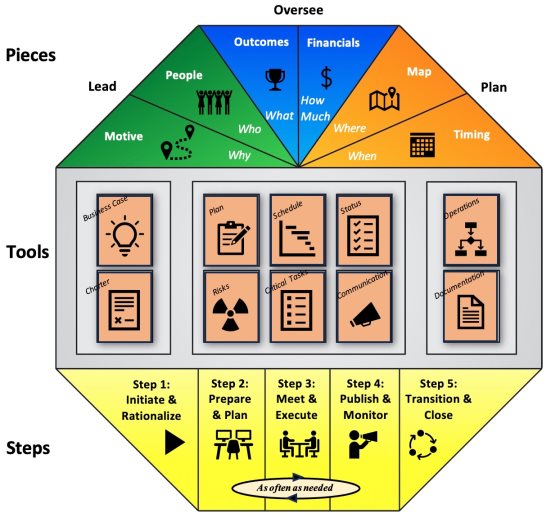
The MPM model lists the project pieces, tools, and
steps to manage a project
5 Steps
In the bottom half of the MPM stop-sign model, there are 5 steps:
Step 1: Initiate and Rationalize is documenting key thoughts to ensure you get what you want and you know what “done” looks like before you get started.
Step 2: Prepare and Plan, is a daily or weekly review and planning to ensure strategy and tactics align, or if a change in direction is required.
Step 3: Meet and Execute, is a daily or weekly focus on collaborative brainstorming for what is most critical to get done daily and weekly to stay on track.
Step 4: Publish and Monitor, is a daily and weekly process to monitor, assist, and communicate, tasks, outcomes, progress, and challenges.
Step 5: Transition and Close, sets up the outcomes for long term success, and moves resources and activities from a project to operational state.
To support moving through those Steps, you need tools that are composed of pieces that you pull together as appropriate for the tool you are using at that time.
Many of the pieces are developed in an initial form when in Step 1, Initiate and Rationalize and then built on as the project proceeds.
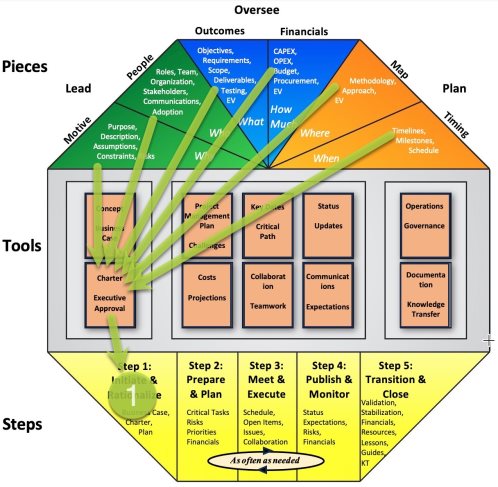
Many of the pieces are developed in an initial form when in Step 1, Initiate and Rationalize when the Charter is being created
The value of thinking of them as project pieces is that they answer some fundamental questions that need to always be asked when starting something of significance; and this may give you flashbacks to your schooling, but we have to go there.
Six Questions
Six important research questions need to be asked for any idea or venture; the 5 W’s and How, come-on think back to high school: Who? What? Where? When? Why? and the ever-present H question – How, or in this case How Much?
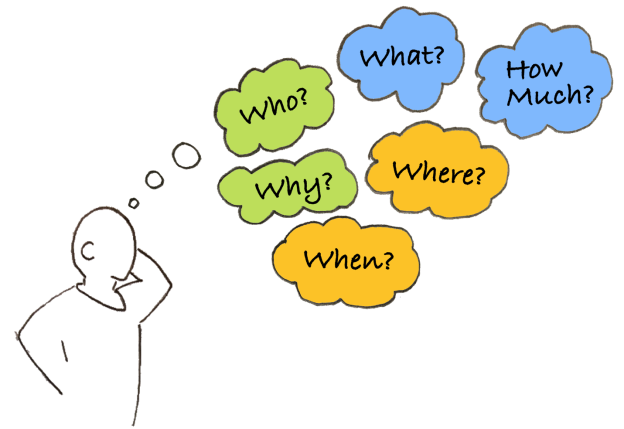
Think about the 5 Ws and the H
Pieces of the Six Questions
The W and H questions include all the pieces you need when starting a project, and for its ongoing management. The top of the stop-sign shaped MPM model has six segments one for each of the 6 questions.
Fill those out and you’ll have defined everything you need to know in your project.
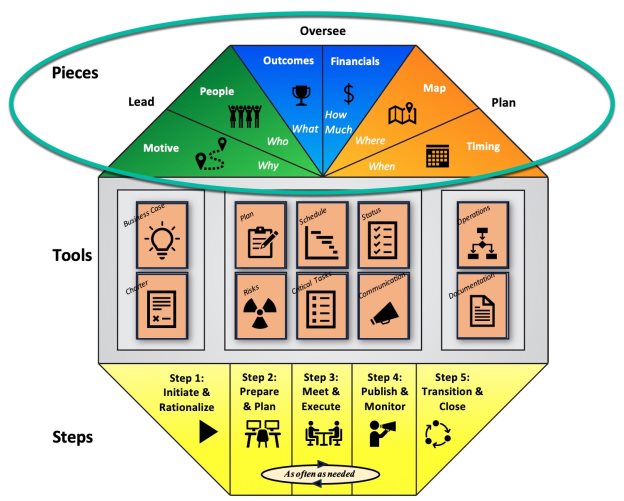
Build your foundation by answering the 6 W and H questions – Concept Model
Documenting the answers to the “W” and “H” questions creates the artifacts you have heard about many times in the project management world, and the MPM model shows you how they fit in.
These artifacts are call project Pieces and each belongs under one of 6 W and H segments at the top of the model: Motive, People, Outcomes, Financials, Map and Timing. These segments are further grouped into domains: Lead, Oversee, and Plan.
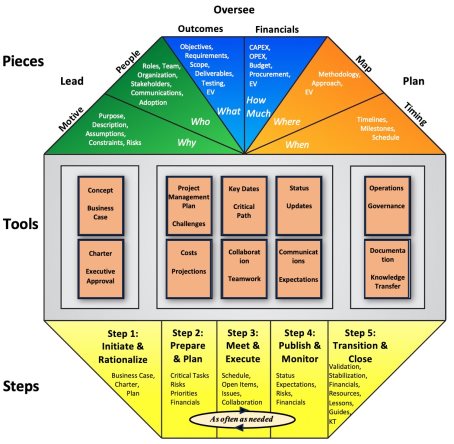
Build the foundation by answering W and H questions – Detailed Model
Pieces
Explaining the 6 questions or segments further:
- Why = Motive: purpose, description, assumptions, constraints, risks
- Who = People: roles, team, organization, stakeholders, communications, adoption
- What = Outcomes: objectives, requirements, scope, deliverables, testing, quality, earned value outcomes
- How Much = Financials:CAPEX, OPEX, budget, procurement, earned value financials
- Where = Map (or Path): methodology, approach, earned value progress
- When = Timing: timelines, milestones, schedule
Tools
The middle of the stop-sign shaped MPM model contains the various tools that are used at each of the steps, that utilize the detail in the pieces.
So these tools use the detail already provided by the pieces to create what each step needs. These will be covered in detail later.
Domains and Segments
LEAD - Motive
- Purpose – A statement about your motivation or reason for doing the project.
- Description – Additional project background information to support your project purpose.
- Assumptions – What needs to be true for your project to succeed.
- Constraints – Guardrails or boundaries which constrain your project.
- Risks – What potential issues could have a negative impact on your project or organization if they occur.
LEAD – People
- Roles – What kind of people are needed, what is expected of them, and who is assigned to that role.
- Organization – The decision-making authority structure for the project roles.
- Stakeholders – Those who most impact, or who are most impacted, by the project.
- Communications – What, how and when for sharing information about the project with the stakeholders.
- Adoption – The project is not successful until the end customer integrates the outcomes into daily habits.
OVERSEE – Outcomes
- Objectives – Statements about objective measures, which when true, fulfill the project purpose.
- Requirements – Mandatory and Optional details desired for the outcomes for the project.
- Scope – The boundaries of analysis and activities for the project.
- Deliverables – The tangible outcomes the project produces.
- Testing – The conformance of deliverables to the project’s Objectives, Scope and Requirements.
- Outcomes EV – Outcomes earned value, or how much of the project outcomes are done versus what was expected to be done.
OVERSEE – Financials
- CAPEX – Capital, asset based, expenditures for the project.
- OPEX – Expense, administrative, disposable expenditures for the project.
- Budget – CAPEX and OPEX spending over the project by weekly or monthly calendar periods.
- Procurement – The process for making large, significant purchases on the project.
- Financial EV – Financial earned value or budget spent versus what was expected to be spent.
PLAN – Map
- Methodology – Any standard template or way of executing used by the project.
- Approach – The path the project is taking to create the deliverables based on the methodology.
- Plan EV – Planned earned value, or what is the Outcomes EV versus the Financials EV within the overall context of the plan.
PLAN – Timing
- Timing – what are the key date requirements for the project
- Milestones – The deliverables and dates important to the stakeholders and project progress.
- Schedule – The approach with calendar dates and timing applied.
The INITIATE and RATIONALIZE step collects initial high level information for each one of the project items above and presents it in a document called the Project Charter.
The charter is reviewed and approved by the stakeholders before the project starts, and it is updated as necessary as the project proceeds.
Step 1: INITIATE and RATIONALIZE
Start Here
The purpose of INITIATE and RATIONALIZE is to make sure your great idea is worth pursuing by asking some questions to round out your perspective and rationalize that there is value in going ahead
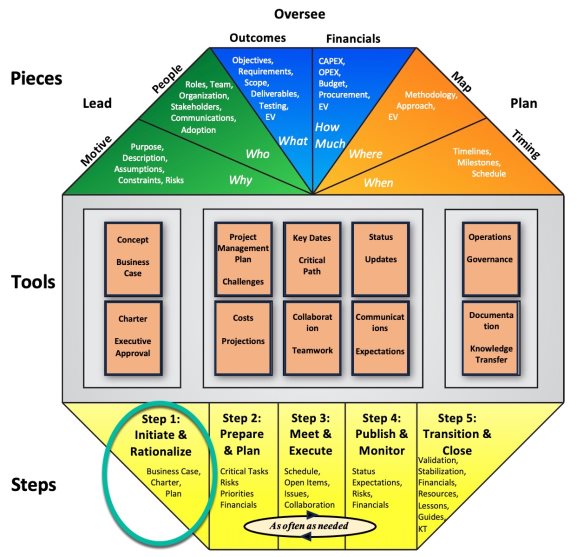
The charter includes high-level initial information from each project piece
INITIATE and RATIONALIZE - Concepts
INITIATE and RATIONALIZE gets your project started on the right foot through a tool called a charter, that has initial high-level information about each project management pieces and it makes you think through the answers to critical questions, such as:
- What is the real purpose, and can it be achieved another way, maybe in less time, or with less cost?
- How will you know when you’ve reached the finish line and is it the same one for everyone else who is supporting you? What does “done” look like?
- How much, roughly, is it going to cost?
- What do you have to watch out for?
Step 2: PREPARE and PLAN
There are five steps to a project, with the middle three repeated each week, or as needed, and it’s the first of those three that is covered here.
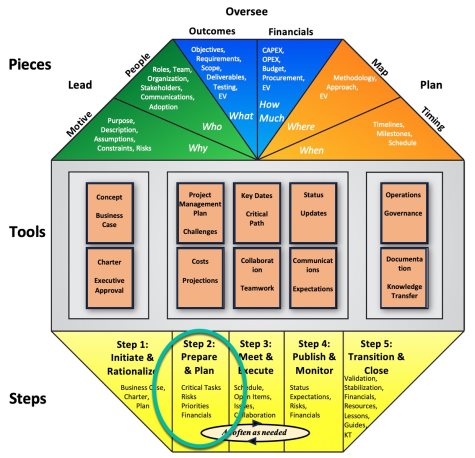
Step 2 of project success
PREPARE and PLAN - Concepts
At the beginning of your project, and then each day or week, prepare for speaking to your team and others by reviewing over your current plan and approach.
Review the approach your project is taking; the steps you are following. Do they still work and make sense? Have they changed or have recent outcomes triggered changes?
How will you know when you’re done? What does “done” look like? Can anyone reach the same conclusions using the same measures without your guidance? Does everyone have the same perspective about “done”?
For this approach, have the skill sets or tools you need changed?
Just open that cocktail napkin a little more so we can see all four squares and answer a couple more questions.
Put down one or two bullets for each of the following: What new constraints do you see, or feel are there?
Have assumptions changed?
What about risks? If something adverse happened, what would it cause, what affect would that have, and how could you mitigate that? This gets you thinking about what to look out for, so add whatever pops into your noggin and you can always add some more detail later.
And lastly, with a thumb in the wind, how much is this all going to run you? Include anyone you have to pay, maybe your own time, and any equipment you may have to buy or rent.
Step 3: MEET and EXECUTE
The middle three steps of the five steps are repeated daily or weekly as needed, and this is the second of those middle three that covers meeting and executing.
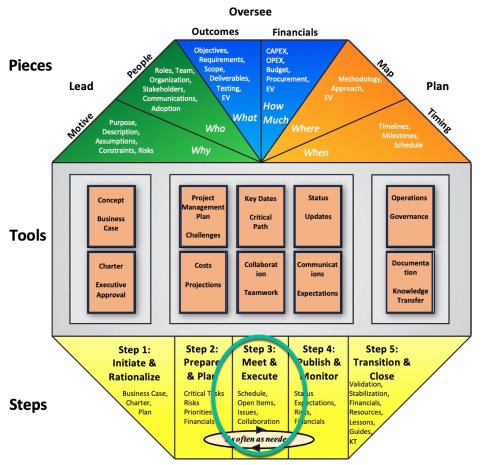
Step 3 of project success
MEET and EXECUTE – Concepts
One of the most important responsibilities of acting in a PM role, besides organizing, planning, and optimizing is to make sure there is daily and weekly progress on those tasks that are the most important at that point in time to keeping the project on track.
The only way you can really do this is to meet frequently with the project team individually or as a group to review the most critical tasks for the day or upcoming days in the week and then following up to get a sense for what is getting done and where there are challenges.
I think it is a mistake for someone in a project management role to assign tasks and expect the project team members to just go away and execute like robots and deliver what is expected when it is expected. It rarely happens that way.
What happens instead is that team members start working on a task or outcome and then run into issues or problems and they need help.
The only way you’re going to find out if they need help or not is if you’re talking to them, if you’re in the trenches with them to observe what’s working and not working.
This doesn’t mean following them around like a puppy dog, or lurking like an online creeper, but connecting with them and building a sense for when they are confident in their solution and when they have concerns.
“Meet and Execute” also means meeting with the Stakeholders and ensuring their expectations are in alignment, because those can fluctuate, and if you keep those lines of communication open, you’ll know when a perspective is changing and how to curb that to make sure it meets the project goals or vice versa, make sure the project goals are modified if there is a looming issue.
Keeping those lines of communication open by meeting individually or as a group with your stakeholders, ensures they’ll have your back when you need it, and you will need it at some point.
Step 4: PUBLISH and MONITOR
There are five steps to a project, with the middle three repeated each week, or as needed, and it’s the third of those three, and the fourth step overall that we’re covering.
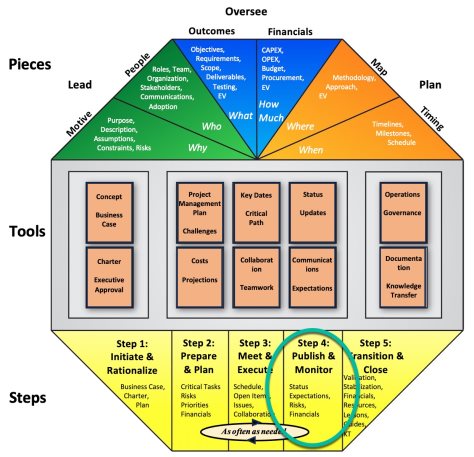
Step 4 of project success
PUBLISH and MONITOR – Concepts
So many times you make the assumption that everyone who has been in the meetings, participated, and nodded to what needs to get done today, tomorrow, and by the same time next week comes away with the same message.
Things were discussed. Everything was covered and clear, right?
But then later you find them working on other priorities that were not discussed and are not critical right now, and they don’t get those items done that day, or that week and then ask for more time. So, your project begins to slip. And that’s how it happens.
The completion of a team discussion about what is critical reminds me of the telephone game, where participants sit in a circle facing each other and the starter person whispers a sentence in the ear of the person to their left who whispers what they heard to the person to their left and so on around the circle until the single sentence message arrives back to the starter.
Just like the instructions to a team, it’s always surprising what comes back because often it doesn’t resemble at all what was initially said; or worse, conveys an action that is entirely different than what should have been conveyed.
Wearing the project leader hat, you’re the starter person, and of course what’s critical is obvious to you, because you spend more time thinking about it than everyone else.
But everyone else has many other urgent and critical priorities that have nothing to do with you or your project, and you’re just one of their priorities, and maybe even not the highest one.
Never assume that your team and stakeholders know what is due today, tomorrow, and next week based on a verbal discussion.
That’s why you need to publish, or somehow communicate to allow review and contemplation by the team, the outcomes expected today, tomorrow, and over the next few days. And then create an easy-to-consume way to review if those outcomes are getting done or not and to what extent?
Having written published, simple itemizations of what needs to get done allows you to have productive follow-up discussions when you’re monitoring to understand how things are getting done.
Step 5 TRANSITION and CLOSE
Finish Here
TRANSITION finishes your project by covering the final things to do once your project is complete.
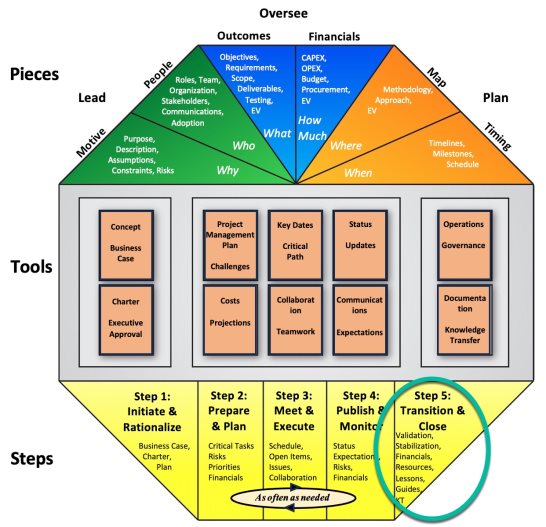
TRANSITION and CLOSE – Completes your project
TRANSITION and CLOSE - Concepts
TRANSITION and CLOSE sets up your project outcomes for on-going success.
It involves moving any project activities that need to continue after the project is done to someone’s daily or weekly routine, so the project outcomes continue successfully in an operational state.
It is also about leaving behind, but in an organized way, the project resources and details that are no longer active after the project is done but may be needed for reference at some point in the future or may need to be wound down and archived.
Transition is a transfer of responsibilities from the project manager and project team to the daily and weekly routines of someone else in the operational environment.
It may be the same people supporting it operationally as who were supporting it in the project, but the situation has changed, because the allocation of their time, and the priority for use of their time, is now under an operational budget, not a project budget, which appears in a different bucket on the financial accounts and it’s reported differently. Transition then also has financial implications.
Transition involves finding new life and ownership for the parts of the project which need to continue after the project is complete and leaving behind the inactive project-specific activities which no longer need to be performed, but leaving them in an appropriate state.
The danger in skipping the TRANSITION and CLOSE part of your project, is that the outcomes that the project team worked so hard to create and make work may not survive long term in an operational state and may degrade or be deprecated.
Summary
The Manager Project Management or MPM Model has everything you need to manage your project from start to finish. It is a complete set. Nothing else is required.
The model is shaped like a stop sign to cause you to stop and ensure you are taking the steps to make you successful.
At the top, the 6 segments answer all of the questions needed to build all of the project pieces you need, and they are grouped into 3 domains.
At the bottom are 5 steps, one to start, three to execute weekly, and the final one to finish your project. The steps utilize the detail in the pieces from the 6 segments through the use of tools which pull in the pieces as appropriate.
Action Steps / Apply This Knowledge
- Create a simple INITIATE document, and call it a Project Charter, with the headings from above and just a couple of sentences under each as a starting point for your project. An actual document template and some examples are covered in the workshops, but for now creating a quick overview document for yourself can be very helpful.
- If your project has already launched, do it anyway as it can be revealing about conversations that you can have with your stakeholders for clarification.
- Follow the weekly steps 2, 3, and 4, to minimize the amount of time it takes you to manage the project weekly, to ensure its success.
- If your project has recently finished, and you have not completed the TRANSITION activities then do that now and the “How To” for TRANSITION blog post contains more detail on this.
- Prompt engineering guidance for AI GPTs such as chatGPT: “I’m a business leader launching a project whose purpose is Y, and delivering X. What are the important pieces my project needs to contain to ensure I have all of the detailed information I need to complete my project successfully?”
Learn More to Do More
Business evolves through change initiatives otherwise known as projects. The key to managing these change initiatives so you have more time, and less stress is to use simple strategies and tools.
Check out the Learning Hub’s other Articles with Actionable Steps, organized with a busy leader in mind, by topic or main idea, and with some AI GPT (e.g. ChatGPT) prompt engineering suggestions under the Action steps: https://simplepmstrategies.com/learning-hub-index
PM MPM – Project Management Overview
© Simple PM Strategies 2024
